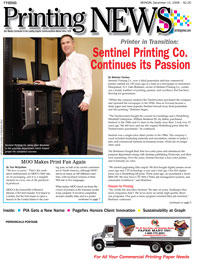|
  Dec. 15, 2008—"We love to print." That's the sentiment emblazoned on MOO's Web site, on its packaging, and it is a tangible element in every one of the products it produces. Dec. 15, 2008—"We love to print." That's the sentiment emblazoned on MOO's Web site, on its packaging, and it is a tangible element in every one of the products it produces.
MOO is the brainchild of Richard Moross, CEO and founder. It is based in London, but the firm hopes to open a branch in the United States in the coming year, as half of its current customers are in North America, although MOO serves as many as 180 different countries, with localized versions of their Web site in five languages.
What makes MOO stand out from the crowd of printers is the business model it has adopted. It revolves completely around variable data, and is a poster child for how the concept, when taken outside of the traditional box, can be a huge success.
A Little Background
MOO started out as an idea in 2003, when Moross wanted to launch what he calls a "business card for your social life." The idea was to sell a printed product with free access to an online service. However, in 2004 when the company was ready to go to market, there was a boom of services like MySpace and Facebook in the online social life space. So Moross changed it up, and decided it was better to partner with these services than try to be a competitor.
At that point, the company, "really focused on building a fantastic, high-quality printed product," said Moross. And that's exactly what they've done.
Paper stock is the first place where MOO sets itself apart. The company positions itself as an "affordable premium product," so it seeks out the best stocks for both look and feel. "[We are] very particular and anal about this," noted Moross. "The entire company gets involved in the paper selection." Right now, MOO offers two main stock choices, a luxurious bright white, 140/150-pound stock, and a 100-percent recycled option that is seeing a huge response. Almost all of the firm's products are laminated using a thick matte substrate.
"It's not enough to be a Web company that's just about price," Moross noted. "It has to be very high quality, and very easy to use at the same time. This is a key part of our vision."
The company outsources all of the actual print work to a company running HP Indigo machines. However, MOO gets the uncut sheets delivered back to them, where it handles the finishing and packing in-house, by hand.
According to Moross, they've thought about bringing the print in-house, and have even done some research on it. But in the end, for now, they decided to focus their efforts and resources on customer service and quality, as well as their software, instead. And that investment is paying off, since a large percentage of MOO's sales are from repeat customers.
"We just want to be a great provider of print to our customers," said Moross. "We want to give them options, package tracking, good shipping rates, etc. And we want to be closer to them for shorter turnarounds, etc."
Setting Themselves Apart
If MOO was just printing high-end business cards, it probably wouldn't be as successful as it has been. Instead, the firm offers customers the option to make every single card, sticker, or note card in a pack different. Customers can choose from templates MOO's designers have created, or they can upload and use their own images. There's no price difference if someone chooses to print all of the same cards from a template, or 100 different images they've uploaded themselves.
In addition to the standard business cards, MOO offers minicards, sticker books, notecards, postcards, and greeting cards. The minicards are by far, according to Moross, the firm's most popular product. In fact, the firm has designed and now sells holders specifically for the minicards, as well as a customized frame designed to hold 20 different minicards.
How do people use the minicards? Social networks, which were the original target market, are still a major player for MOO. "At the macro level, people are living virtual lives, socially networking online, and that has resulted in this great desire to be tactile again," noted Moross. "But people still have events, still get together. They have become more alienated in some ways, and print helps them connect and
get together."
And the concept expanded from there. Professional photographers are using the cards as a way to carry their portfolio around in a manageable way. Architects are putting images of their designs on the cards for the same purpose. Designers are creating stunning little works of art they can leave behind and get remembered. Consumers are creating everything from personalized Christmas cards to gift tags, to wedding announcements and everything in between.
And the firm isn't stopping there. MOO has plans to offer more products and accessories in the future, in addition to expanding its reach. In fact, if the U.S. expansion proves successful, the company is considering opening offices in additional locations as well.
This is most definitely a company to keep a close eye on as it continues to expand and grow. It is proving that variable data isn't just a fad, and that the Internet and online media don't have to mean the death of print. Putting those two ideas together has resulted in a business model seeing outstanding growth and success, in an industry struggling to find its footing in the new century.
|


